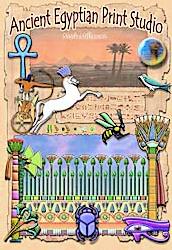
Ancient Egypt Magazine
Volume Four Issue Three -- December 2003 / January 2004
Netfishing by Hapy
It’s a curious thing, but often the easier things are, the easier we want them to be. Access to the internet provides a perfect example. ‘Just a mouse click away’, we’re promised, from everything we could possibly want to know – and things that we definitely don’t – and yet for some that’s not enough.
This should provide some comfort to those who think that information needs some processing expertise applied to it before it’s on general release. What makes an expert? Not an individual who claims to know everything about everything, surely, more one who has spent a great deal of time and effort finding out what knowledgeable others think on a particular topic before putting forward their own views.
Gratifyingly, there’s still a value put on this as witnessed by massive amounts of questions put to Ancient Egypt magazine. Sometimes the questioner wants to con- tact an expert in a particular topic, which just isn’t always possible; sometimes advice on suitable reading based on someone’s personal experience; some- times the enquirer is in need of a specific reference which one of the contributors to AE can provide.
And sometimes – quite a lot of the time, actually – the questioner wants someone to do their school or college project for them. In the time it takes to put ‘pyramids Egypt’ or ‘Cleopatra’ or ‘Amarna Period’ into a search engine, the student, showing hugely commendable initiative it must be said, chooses rather to send a flattering e-mail to the magazine. After several paragraphs of outrageous blandishment, and only then, does the e-mail conclude ‘Can I interview you on the subject of pyramids (Cleopatra, Akhenaten, Alexander the Great, Tutankhamun, Life, the Universe and everything, delete as applicable) for my class project? Please send me all the information you have on the topic.’
One genuine, frequently received plea usually from harassed parents under pressure, or possibly from their offspring masquerading as mummy – is where to find royalty free images of Egypt for various projects. It would be mean to suggest typing ‘Free images Egypt’ into the search engine but oddly enough that does the trick. (Teacher: ‘Go and look it up!’)
A good starting point is www.egyptarchive.co.uk the web site of Jon Bodsworth who has provided images to accompany features in this magazine.
This is where expertise comes in – we can assure you that Jon’s web site has a keen following and comes in for a lot of praise in various sources.
Another web site clearly promoting the royalty free idea is http://historylink101.net/egypt_1/pic_main.htm where there are masses of images to browse through.
Mark Millmore has come in for praise in the past and his site, www.eyelid.co.uk should definitely be on the list for an example of how to pres- ent artwork beautifully. Look on it as an inspirational resource to encourage you to develop your own ideas.
The paintings of David Roberts are known and appreciated by all aficionados of Egypt and therefore it’s well worth taking a look at http://www.softforall.com/Desktop/Screensavers/Egypt_of_David_Roberts03060107.htm. And, of course, there’s the excellent Neferchichi.com, a major function of which is to provide refreshment and encouragement for anyone under ‘project pressure’.
For those in more demanding need of images, look at Ian Butterfield’s site www.imb.biz. Ian is a professional, award winning photographer and so as far as we’re aware these are not royalty free. They include images of Egypt and the Middle East, particularly Jordan (that’s the place, obviously, not the ‘celebrity’).
Finally Digiglobe.com has a gallery of satellite views, sent by satellite QuickBird which are astonishingly and scarily detailed. Archaeologists are amongst the beneficiaries of these aerial views – another expert recommendation.
Whenever an image is used, whether royalty free or not, it’s correct to attribute it properly for class projects but obviously we don’t need to tell you that because you will have done your homework. And we won’t have done your homework.
HAPY

Above: A catalogue cover from Mark Millmore’s excellent site, www.eyelid.co.uk on the list for an example of how to present artwork beautifully.
Back to Volume Four Issue Four - February/March 2004 contents